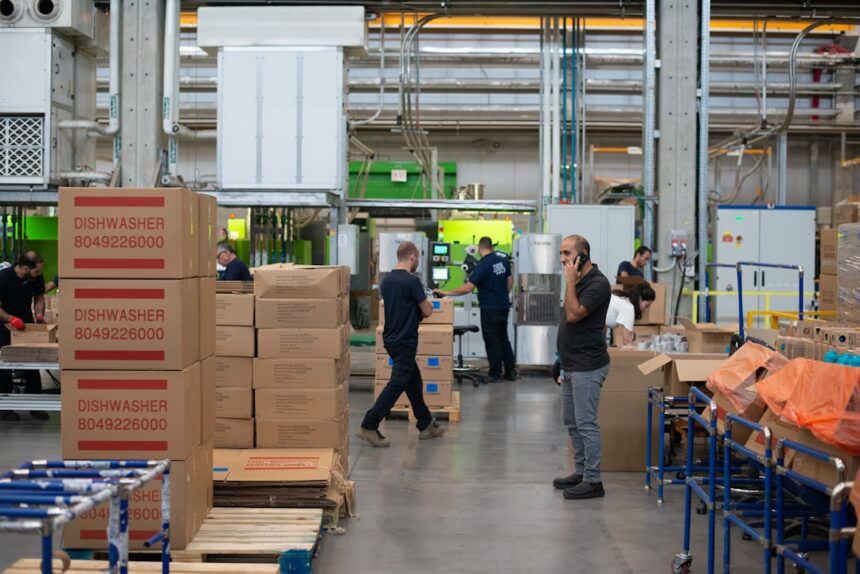Efficient warehouse management is a complex dance that blends spatial awareness with strategic thinking. When it comes to maximizing the potential of your warehouse space, there’s no one-size-fits-all solution. Leading the path of optimization requires meticulous planning, constant innovation, and a deep understanding of your operational needs.
In this guide, we’re not just abstractly preaching the merits of warehouse optimization; we’re rolling up our sleeves, digging into the nitty-gritty, and delivering actionable insights to help you transform your storage facility into the epitome of efficiency.
If you’re ready to unlock the potential of your warehouse layout, read on as we decode the intricacies of space utilization and reveal the industry’s best practices.
Understanding Warehouse Flow
The natural movement of materials within your warehouse — from the moment goods enter your receiving area to the second they leave—is your warehouse flow. It’s critical to understand this flow as it lays the foundation for an optimized layout.
Begin by mapping out the path of your most popular items, also known as A-class items. How quickly can they be accessed, picked, and dispatched? Often, laying out your storage according to the Pareto principle (80-20 rule) eases the movement of items, placing the most frequently accessed goods closest to the shipping area.
Next, consider batch picking. Group items and orders together in a way that reduces the distance traveled by your pickers. Zones with high-velocity items close to the shipping area and low-velocity items further back will facilitate a more streamlined operation.
Designing for Vertical Space
Warehouses are typically cavernous, leaving a lot of room above your head, or rather, above your inventory. Utilizing this vertical space is more than merely stacking items; it’s a strategic approach to expansion.
Investing in high-quality shelving and racking systems designed to accommodate forklifts and other vertical storage equipment is crucial. Additionally, consider the implementation of mezzanine levels or automated vertical storage systems like AS/RS (Automated Storage and Retrieval Systems). These offer significant space savings, reduce picking and retrieval time, and improve the overall accuracy of order fulfillment.
Implementing Lean Storage Techniques
Lean principles are not exclusive to manufacturing; they are incredibly potent in warehouses, too. One of the fundamental concepts of lean storage is 5S — sort, set in order, shine, standardize, and sustain.
Start by eliminating redundant items and materials that aren’t moving. Sort and categorize your remaining inventory, setting them in an order that’s logical and conducive to smooth transitions. Maintain cleanliness within your warehouse, then standardize procedures to ensure that the order you’ve established becomes the norm. And finally, sustain these practices by making them part of your warehouse culture.
Another lean practice worth considering is Just-in-Time (JIT). Adopting this approach means receiving goods only as they are needed in the production process, reducing inventory holding costs and minimizing waste.
Balancing Efficiency with Safety
Efficiency cannot come at the cost of safety. A warehouse that’s optimized only for space and speed, without consideration for safety protocols, is a ticking time bomb for accidents and downtime.
Institute clear pathways and zones for forklifts and other machinery, separate pedestrian lanes and ensure the proper labeling and signage of hazardous materials. Regular safety training updates for staff, as well as implementing proper safety gear and procedures, is non-negotiable.
Furthermore, consider the load-bearing capacity of all your pallet racking, shelving, and mezzanine systems. Vigilance here is key; often, what seems like a small oversight can lead to catastrophic consequences. Ensuring the integrity of your warehouse’s structure with heavy duty pallet racking is essential to not only maximize space but also to safeguard against potential accidents and inventory damage. The same attention should also be given to maintaining a well-organized and clean warehouse, as clutter can lead to safety hazards.
Navigating with Technology
The adoption of technology within the warehouse has transitioned from a competitive edge to a baseline requirement. Incorporating a Warehouse Management System (WMS) offers real-time visibility, which is invaluable for decision-making.
Barcoding and RFID technology simplify inventory tracking, leading to more accurate management of stock, while Pick-to-Light and Put-to-Light systems guide employees to items with precision, dramatically reducing picking time.
Perhaps, the pinnacle of technology in warehouse optimization is Voice-directed picking systems. These hands-free systems provide operators with instructions and information, enhancing accuracy and productivity without impeding on the employee’s mobility.
Adapting to Ever-Changing Demands
The ebb and flow of consumer demands can put considerable strain on your warehouse. Seasonal fluctuations, sudden trends, or even unexpected events can require your space to be fluid and adaptable.
Prepare for such shifts by incorporating modular storage systems that can be easily reconfigured. Keep a flexible workforce to handle surge seasons, and employ cross-docking strategies to swiftly move goods from inbound to outbound with minimal storage time.
It’s also vital to maintain a robust communication channel with suppliers and clients, ensuring the smooth flow of information about changes in product demand and delivery schedules.
Continuous Improvement Strategies
Optimizing your warehouse layout is a marathon, not a sprint. To stay ahead, you must be committed to continuous improvement. Regularly audit your operations, conduct time-motion studies, and gather feedback from your warehouse staff, the front lines of your operation.
Look for areas where processes can be streamlined or steps can be eliminated. Celebrate small wins and constantly re-evaluate your technology stack to ensure you’re always using the most up-to-date and efficient tools.
Remember, change is daunting, but it’s the lifeblood of progress. Stay nimble, be prepared to adapt, and never lose sight of the goal: a warehouse that’s not just a storage space but an engine of your business’s growth.
Maximizing your warehouse space is a multifaceted endeavor that necessitates both the art and science of spatial organization. By understanding these fundamental principles and implementing them in your warehouse layout, you can create a lean, efficient, and adaptable storage facility that’s ready to meet the ever-changing demands of your business. Remember, optimization is an ongoing process; stay vigilant, embrace change, and continuously strive for improvement. Your warehouse—and your business—will thank you for it. So keep working on improving your warehouse













